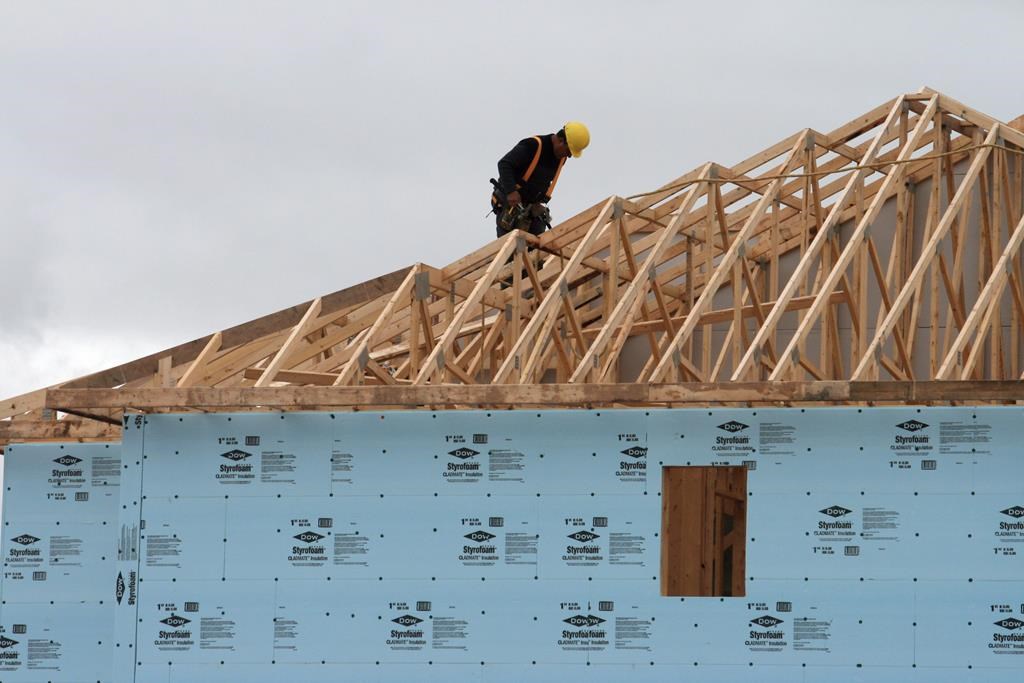Labour shortage in construction adding extra pressure to housing supply gap: experts

The construction industry is short tens of thousands of workers, and experts say a coming wave of retirements could make the problem worse even as Canada is millions of homes behind what’s needed to reach housing affordability this decade.
“That labour shortage is going to remain, and it’s only going to increase,” said Reva Bond, dean of the construction school at the Southern Alberta Institute of Technology.
The job vacancy rate in construction is at a record high with around 80,000 vacancies in the industry, said CIBC deputy chief economist Benjamin Tal in a recent note.
Advertisement
Those vacancies, which push up building costs and impede productivity, come at a time when the residential construction industry is under pressure to meet the demands of a growing population.
The Canada Mortgage and Housing Corporation forecasts a need for 3.5 million more homes by 2030 than the country is currently on track to build.
The number of new homes built, however, has been in decline, from just over 271,000 in 2021 to 260,000 in 2022. And in May this year, the annual pace of housing starts dropped 23 per cent month over month, leading the CMHC’s chief economist to predict that just 210,000 to 220,000 new homes will be built by the end of the year.
There are several factors that CMHC credits for this gap, and labour shortages are one, alongside higher interest rates, rising building costs and zoning problems.
It will be “incredibly challenging” to meet housing demand with a labour shortage in construction putting further strain on housing supply, said CMHC deputy chief economist Aled ab Iorweth.
Advertisement
But industry experts don’t see the labour gap closing any time soon.
“It’s been years in the making,” said Kevin Lee, CEO of the Canadian Home Builders Association.
For more than two decades, Lee said there’s been a shift away from directing younger generations into skilled trades, and toward what he calls the “knowledge economy.” That comes alongside a growing shift on the other end of the labour force, where around a fifth of the industry is set to retire in the coming decade, he said.
“But obviously … the need to build homes has never gone away,” Lee said, adding that there’s also growing demand for workers on the renovation side of residential construction.
The labour shortage is significantly affecting productivity in the industry, as well as creating safety concerns, said Tal.
Advertisement
This was echoed by a recent industry survey by construction management software company Procore, where almost 30 per cent of respondents said they have been unable to take on more projects in the past three to six months due to labour shortages.
However, the labour shortage has also given workers in the industry more bargaining power amid the rising cost of living, and pay is reflecting that. A recent note from RBC said wages in the sector grew 9.4 per cent in 2022, nearly double other industries.
Despite efforts by schools like SAIT to speak to high school students, and an array of credit programs and scholarships, it’s still tough work to attract the younger generation to the sector, said Bond. The volatile nature of the work, which pays well hourly but can vary depending on demand, has also led some to leave the sector, she said.
Efforts to recruit more women and under-represented groups into the trades have made headway, but Bond said there’s been too much focus on recruitment and not enough on retention. Companies need a push to develop more inclusive practices, she said, to ensure that recruits from different backgrounds actually stay in the field.
Of course, the labour shortage is just one of the issues contributing to a housing supply gap, noted Lee — higher material costs, regulatory red tape and higher interest rates are all weighing on the building of new homes, he said.
Advertisement
Just as there are multiple factors contributing to the housing supply gap, there are multiple ways to address the labour shortage in construction, said ab Iorweth: “There’s no silver bullet.”
In the labour report, CMHC proposed a number of solutions, including converting existing commercial buildings into residential units, building more multi-unit housing, further incentivizing people to enter the construction field, and creating more targeted immigration programs to help bring in workers to the trades.
While more needs to be done to attract people to the sector, the construction industry should also seek to improve technology and innovation in order to help ease the gap, ab Iorweth said.
Lee said one innovation that has the potential to streamline construction is the adoption of modular construction, where some aspects of the construction process are done in a factory instead of on-site, with more opportunity for automation. He said the CHBA is working on an industry transition strategy that would look to government to help address some of the risk of adopting this technology, in particular the overhead costs, to encourage more widespread adoption.
Lee also said a higher percentage of immigration needs to be allotted to people in skilled trades. In May the federal government announced the launch of category-based selection for the Express Entry and included trades as one of the top priorities for work experience, which he said is a step in the right direction.
Advertisement
But while bringing in more immigrants with skilled trades experience is welcome, Bond said it’s important that the industry looks at how to retain those workers.
Much like with the younger generation of Canadians that the industry is trying to hire, she’s concerned there isn’t enough attention being paid on how to make construction jobs attractive over the longer term.
“Right now, we are not setting the next generation up for success,” she said.
This report by The Canadian Press was first published July 2, 2023.
Advertisement
Rosa Saba, The Canadian Press